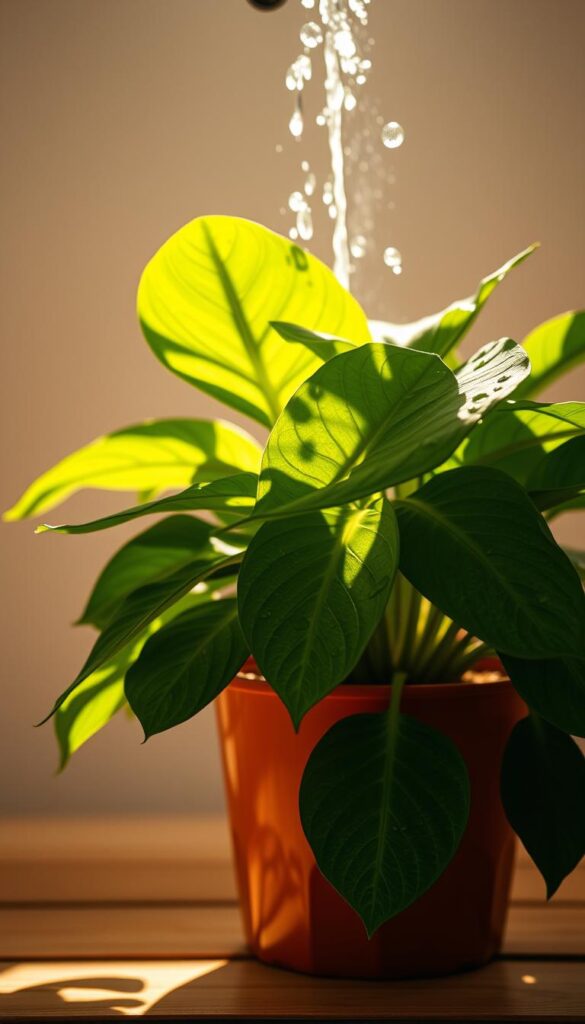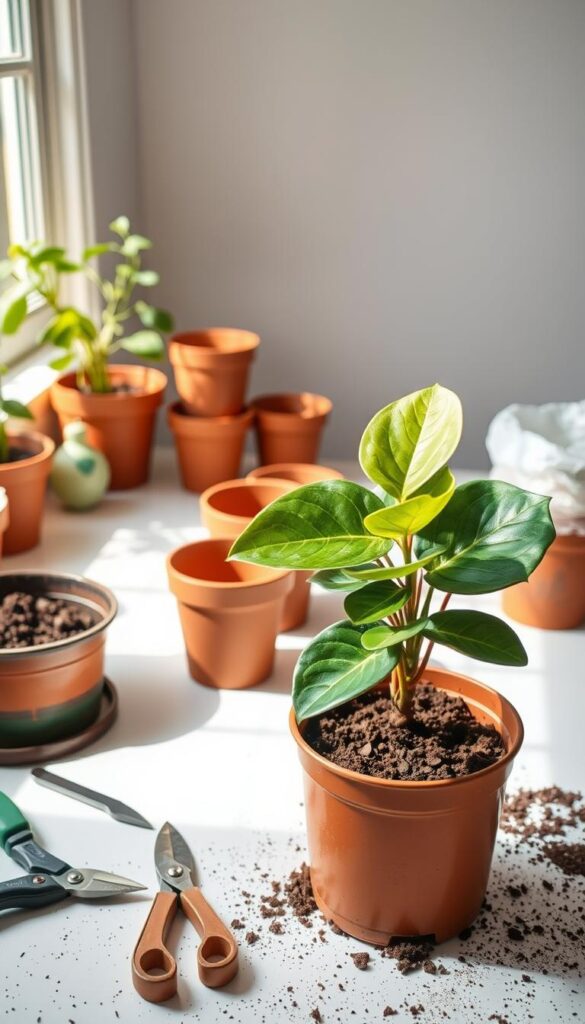My journey with the Philodendron Royal Queen began like many others—excitement quickly followed by uncertainty. This stunning plant, with its large, velvety leaves, captivated me, but I soon realized that keeping it thriving wouldn’t be effortless.
Through trial and error, I discovered the key to its happiness: balance. Watering became a science—0.5 cups every 9 days to prevent root rot. Placing it near a south-facing window provided the perfect indirect light, ensuring those beautiful leaves stayed healthy and vibrant.
The right soil was another puzzle piece. A well-draining potting mix made all the difference, allowing the roots to breathe and absorb nutrients efficiently. These elements, while simple, are crucial for anyone looking to bring out the best in their Philodendron Royal Queen.
Understanding and meeting these needs transformed my plant’s health. By focusing on water, soil, and light, I created an environment where my Philodendron could flourish. In the following sections, I’ll delve into each of these areas, sharing practical tips to help you achieve the same success with your plant.
Understanding My Philodendron Royal Queen
Getting to know my Philodendron Royal Queen has been a fascinating journey. This stunning houseplant, with its large, velvety leaves, has captivated me, but understanding its needs has been key to its success in my home.
Origin and Botanical Background
The Philodendron Royal Queen hails from the lush regions of Central and South America, as well as the Caribbean. Its natural habitat is in tropical areas, where it grows as an epiphyte, clinging to trees for support. This background explains its climbing nature and the need for a well-draining potting mix to prevent root rot.
Unique Characteristics and Growth Habits
This houseplant is known for its impressive size, reaching up to 3 feet tall, and its large, velvety leaves that can grow up to 12 inches in length. The leaves are a deep green color with hints of copper, adding to their allure. The plant’s growth habits are adaptable, thriving in both climbing and trailing forms, making it versatile for different spaces.
Recognizing healthy leaves is crucial. Healthy leaves are a vibrant green, firm to the touch, and have a glossy appearance. Signs of stress include yellowing leaves, droopy stems, or slow growth. Regular inspection can help catch these issues early, ensuring the plant remains healthy.
| Characteristic | Healthy Plant | Stressed Plant |
|---|---|---|
| Leaf Color | Deep Green | Yellow or Pale |
| Leaf Texture | Firm and Velvety | Soft or Wilted |
| Growth Rate | Steady | Slow |
A weekly care routine helps monitor the plant’s condition. Checking the soil moisture, inspecting leaves, and adjusting light exposure are essential tasks. This routine ensures the plant’s needs are met, promoting healthy growth and preventing potential issues.
Understanding the plant’s background is vital for effective care. By tailoring routines to its natural habits, I create an environment that supports its health and beauty. This approach ensures my Philodendron Royal Queen continues to thrive, bringing joy and elegance to my home.
Watering, Light, and Soil Essentials
Watering is one of the most critical aspects of keeping my plant healthy. I follow a simple yet effective routine to ensure it gets just the right amount of moisture.
How I Determine the Right Watering Schedule
I water my plant with 0.5 cups of water every 9 days during the spring and summer when it’s actively growing. This schedule helps prevent root rot, a common issue if the soil stays too wet.
To check soil dryness, I stick my finger into the soil about an inch deep. If it feels dry, it’s time to water. A water calculator also helps me adjust based on the pot size and light exposure.
Maintaining the right humidity is crucial. I keep the humidity between 40-70% to prevent fungal growth on the leaves, which can harm the plant.
Choosing the Perfect Spot for Indirect Light
Near a south-facing window is the ideal spot for my plant, but I keep it at least 6 feet away to avoid direct sunlight. This setup provides the right amount of indirect light for healthy growth.
The environment inside my home plays a big role in the plant’s well-being. I ensure good air circulation and maintain a comfortable temperature to support its growth.
| Characteristic | Healthy Plant | Stressed Plant |
|---|---|---|
| Leaf Color | Deep Green | Yellow or Pale |
| Leaf Texture | Firm and Velvety | Soft or Wilted |
| Growth Rate | Steady | Slow |

philodendron royal queen care guide: Detailed Steps for Success
Ensuring my plant receives the best possible care involves a few key steps that I’ve learned over time. It all starts with the right foundation—soil and nutrients.
Optimal Soil and Potting Mix for Drainage
Selecting the perfect potting mix is crucial. I use a well-draining mix to prevent waterlogged soil, which can lead to root rot. The soil should retain enough moisture but drain excess water quickly. This balance ensures healthy root growth.
Simple Nutrient and Fertilizer Tips
Nutrients are essential for vibrant growth. Fresh potting soil usually provides enough nutrients for the plant. I repot my plant once a year or when it doubles in size to replenish the soil. This ensures my plant has the nutrients it needs to thrive.
| Aspect | Optimal Condition | Action |
|---|---|---|
| Soil Moisture | Dry to the touch | Water thoroughly |
| Nutrient Levels | Adequate | Repot annually |
| Soil Structure | Well-draining | Use a quality mix |
Understanding when to water and fertilize is key. I check the soil dryness by inserting my finger about an inch deep. If it’s dry, it’s time to water. I also consider the time of day and season to ensure I’m providing the right conditions for my plant to flourish.
Creating the Ideal Environment
Setting up the perfect space for my plant has been a game-changer. Balancing temperature and humidity creates a thriving environment that supports healthy growth and vibrant leaves.
Temperature and Humidity Considerations
I maintain a consistent temperature between 65-75°F (18-24°C) to keep my plant comfortable. Humidity levels are kept between 40-70% to prevent fungal issues and maintain leaf shine. Daily monitoring ensures these conditions stay optimal.
Placing Your Plant for Best Growth
Proper placement is key. I position my plant near a south-facing window for indirect light, about 6 feet away to avoid direct sun. This setup promotes steady growth and lush foliage, essential for its well-being.
Minor adjustments, like using a humidifier or relocating the plant, can significantly enhance its vitality. These small changes prevent issues like fungal diseases and overheating, ensuring a nurturing environment.
By focusing on these environmental factors, I’ve created a home where my plant can reach its full potential, bringing beauty and life to my space.
Repotting and Growth Maintenance Tips
Repotting my plant is a crucial step in its growth journey. It’s not just about giving the roots more space but also about refreshing the soil to ensure vibrant growth.
When and How I Repot My Plant
I monitor the plant’s stem and root health closely. If the roots start to circle or the plant slows its growth, it’s time to repot. Typically, this happens once a year or when the plant has doubled in size.
Choosing the right pot and potting mix is key. I opt for a pot that’s slightly larger and a well-draining mix to prevent waterlogged soil. This ensures proper drainage and access to fresh nutrients.
| Aspect | Optimal Condition | Action |
|---|---|---|
| Root Health | Visible, not circling | Repot annually |
| Drainage | Excess water flows out | Use well-draining mix |
| Sunlight | Indirect, south-facing | Place near window |
The repotting process is gentle. I remove old soil carefully and place the plant in the new pot, ensuring the root system is intact. Proper sunlight exposure supports sustainable growth, making repotting a vital part of maintaining plant health.

Troubleshooting Common Issues
Every plant parent encounters challenges, and my journey with this stunning houseplant has been no exception. Learning to identify and address common issues has been key to keeping my plant thriving. Here’s how I handle some of the most frequent problems.
Identifying Overwatering, Underwatering, and Root Concerns
One of the first things I learned was how to spot overwatering. If the leaves start to turn yellow and droop, it’s a clear sign that the roots are waterlogged. I check the soil by sticking my finger in about an inch deep. If it’s wet, I wait a few more days before watering again. Underwatering is easier to miss, but I look for leaves that are crispy or wilted. Finding the right balance has been crucial.
Managing Leaf Health and Spotting Signs of Stress
Healthy leaves are firm and have a glossy appearance. If I notice any that are soft or wilted, I inspect the plant more closely. I also make sure to clean dust from the leaves regularly to keep them healthy. Maintaining the right temperature between 65-75°F (18-24°C) helps prevent stress. I’ve found that monthly checks are essential to catch any issues early and adjust my care routine as needed.
Creating Space and Improving Airflow
Proper airflow is often overlooked but is vital for a plant’s health. I ensure there’s enough space around my plant to allow air to circulate. This helps prevent fungal diseases and keeps the leaves healthy. I’ve also noticed that good airflow encourages steady growth and vibrant foliage. It’s a simple adjustment that makes a big difference.
By following these tried-and-true methods, I’ve been able to address common issues effectively. Regular inspections, proper watering, and maintaining the right environment have helped me keep my plant in great shape. Every adjustment I make is based on what I’ve learned through experience, ensuring the best results for my plant.
Wrapping Up My Journey with Philodendron Royal Queen
As I conclude my journey with this stunning houseplant, I reflect on the key elements that have made it thrive. Regular care, proper repotting, and consistent monitoring have been essential in maintaining its health and beauty.
Using the right fertilizer and repotting techniques has significantly improved soil quality, ensuring my plant remains vibrant. I make sure to provide the perfect conditions, keeping the environment balanced and nurturing.
Monitoring for signs of stress, such as spots on the leaves, helps me adjust my watering schedule. This attention to detail ensures my plant stays healthy and continues to flourish.
Nurturing this plant has brought me immense joy and satisfaction. I encourage readers to adopt similar practices, focusing on quality care and attention to detail, to achieve long-term success with their own houseplants.
